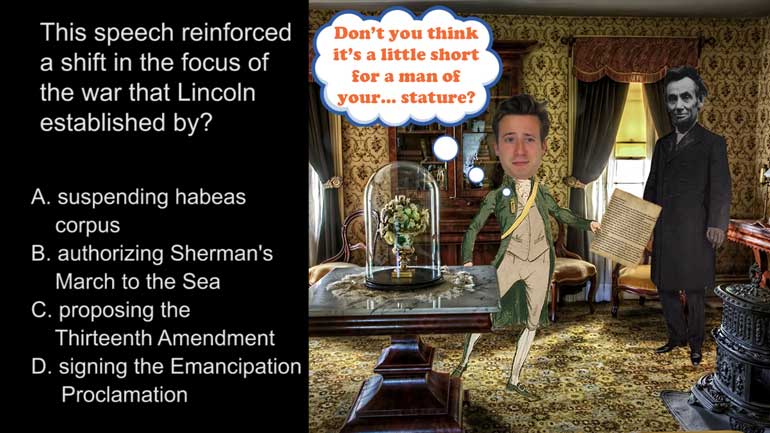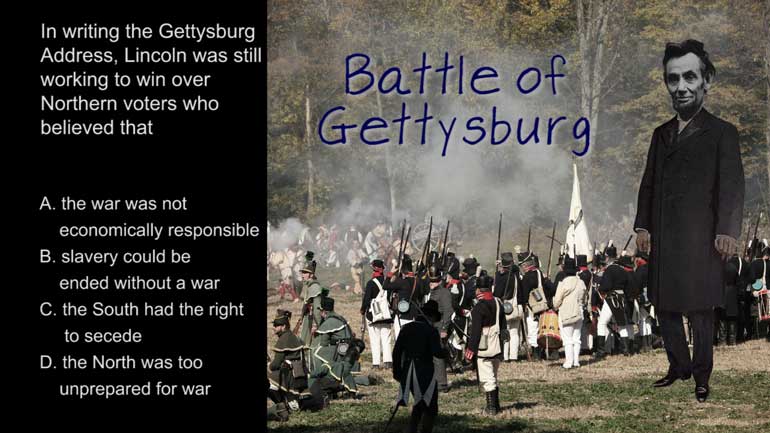ShmoopTube
Where Monty Python meets your 10th grade teacher.
Search Thousands of Shmoop Videos
AP U.S. History 1.2 Period 3: 1754-1800 273 Views
Share It!
Description:
AP U.S. History 1.2 Period 3: 1754-1800. The structure of the government that the Articles of Confederation established most clearly reflects the Republican belief that what?
- Reading Informational Text / Analyze seminal U.S. documents of historical and literary significance
- Reading Informational Text / Analyze seminal U.S. documents of historical and literary significance
- Reading Informational Text / Reasoning in seminal U.S. texts for both legal purposes and public advocacy
- A New Constitution / The Articles of Confederation
Transcript
- 00:00
[ musical flourish ]
- 00:03
And here's your Shmoop du jour, brought to you by the iron fist,
- 00:07
the latest trend in men's gloves. Yeah.
- 00:10
All right, take a look at the excerpt.
- 00:12
[ mumbles ]
Full Transcript
- 00:16
The structure of the government that the Articles of Confederation
- 00:19
established most clearly reflects
- 00:21
the Republican belief that... what?
- 00:24
And here are your potential answers.
- 00:25
[ dog barks ]
- 00:26
All right, well... [ mumbles ]
- 00:29
[ mumbling continues ]
- 00:32
All right. So what's this question asking?
- 00:34
Well, first, it looks like we need to know
- 00:35
what exactly the structure of government
- 00:38
was under the Articles of Confederation.
- 00:40
The only branch mentioned in the excerpt is Congress,
- 00:43
and that's a great clue, because under
- 00:44
the Articles, there was only one branch -
- 00:46
Congress.
- 00:47
So let's keep that in mind as we check out our potential answers.
- 00:50
Did that one-branch system reflect
- 00:52
the Republican belief that A -
- 00:55
the government needs checks and balances?
- 00:57
Well, hmm. In order to have checks and balances,
- 00:59
you kind of need more than one branch of government.
- 01:02
That'd be like saying justice is blind,
- 01:04
but only out of one eye. So it's not A.
- 01:07
Did the Articles of Confederation reflect
- 01:09
the idea that B - citizens should
- 01:11
participate directly in a democracy?
- 01:13
Well, actually, the national legislature
- 01:15
under the Articles was made up of representatives
- 01:17
elected by state legislatures,
- 01:19
not the people themselves.
- 01:21
So it wasn't direct democracy.
- 01:23
More like indirect democracy.
- 01:25
Then did the Articles recommend C -
- 01:27
voting rights should extend to
- 01:29
those who don't own property?
- 01:30
Well, seems fair, right?
- 01:32
Well, not in the eyes of those farmers.
- 01:34
Because if you didn't own property, well,
- 01:36
you couldn't vote. Rentals don't count.
- 01:38
That eliminates C, as well.
- 01:39
So that means the Articles of Confederation
- 01:42
reflected the idea that D - a strong
- 01:44
central government leads to tyranny.
- 01:47
That it did.
- 01:48
Remember what the colonists had just experienced
- 01:50
leading up to the Revolution -
- 01:51
the destructive power of a strong
- 01:53
central government under England's monarchy.
- 01:56
Under British Parliament, the colonists were subjected
- 01:58
to persecution, income inequality,
- 02:01
and civil rights abuses.
- 02:03
So to prevent the American system from following
- 02:05
in its deadbeat dad's footsteps,
- 02:07
our founding fathers created a weak central government with
- 02:10
only one branch, Congress.
- 02:12
So the correct answer is D.
- 02:14
But remember, that one-branch system didn't last.
- 02:16
The Articles were replaced by the U.S. Constitution,
- 02:20
which called for three branches of government.
- 02:22
And we all know the best things
- 02:24
come in threes. Like Larry, Curly, Moe.
Up Next
AP U.S. History Exam 2.45. The journey shown on the map was an example of...what?
Related Videos
AP U.S. History Exam 2.26. This speech reinforced a shift in the focus of the war that Lincoln established by...what?
What did the Spanish messengers bring with them to North America? Hint: you probably wouldn't be thrilled to get this for your next birthday.
AP U.S. History Diagnostic 24. How did the United States choose containment over the National Security Council Report in Latin America?
AP U.S. History Exam 2.25. In writing the Gettysburg Address, Lincoln was still working to win over Northern voters who believed that...what?




